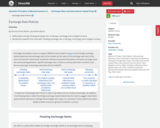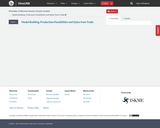
- Material Type:
- Full Course
- Provider:
- Rice University
- Provider Set:
- OpenStax College
- Date Added:
- 06/29/2017



By the end of this section, you will be able to:
Calculate and graph budget constraints
Explain opportunity sets and opportunity costs
Evaluate the law of diminishing marginal utility
Explain how marginal analysis and utility influence choices


By the end of this section, you will be able to:
Differentiate among a floating exchange rate, a soft peg, a hard peg, and a merged currency
Identify the tradeoffs that come with a floating exchange rate, a soft peg, a hard peg, and a merged currency



By the end of this section, you will be able to:
Discuss how international trade influences the job market
Analyze the opportunity cost of protectionism
Explain how international trade impacts wages, labor standards, and working conditions


By the end of this section, you will be able to:
Define absolute advantage, comparative advantage, and opportunity costs
Explain the gains of trade created when a country specializes

By the end of this section, you will be able to:
Show the relationship between production costs and comparative advantage
Identify situations of mutually beneficial trade
Identify trade benefits by considering opportunity costs


By the end of this section, you will be able to:
Calculate the labor force participation rate and the unemployment rate
Explain hidden unemployment and what it means to be in or out of the labor force
Evaluate the collection and interpretation of unemployment data

The Principles of Microeconomics course was developed through the Ohio Department of Higher Education OER Innovation Grant. This work was completed and the course was posted in December 2019. The course is part of the Ohio Transfer Assurance Guides and is also named OSS004. For more information about credit transfer between Ohio colleges and universities, please visit: www.ohiohighered.org/transfer.Content ContributorsKen Fah Ohio Dominican UniversityJohn Fiske Ohio Dominican UniversityJoe Nowakowski Muskingum UniversityLibrarianNathan Wolfe Kenyon CollegeReview TeamMolly Cooper Ohio State University Subbu Kumarappan Ohio State University ATI


This topic introduces key concepts that form the foundation of much of microeconomic analysis. The material ranges from a discussion of model-building as a way to simplify complex relationships among economic variables to definitions and descriptions of key concepts such as scarcity, efficiency and inefficiency, opportunity cost, comparative advantage and the gains from trade.